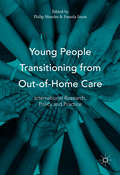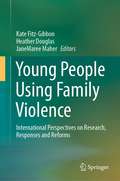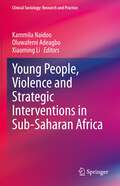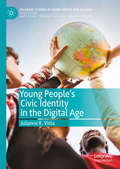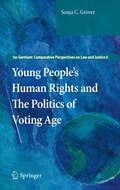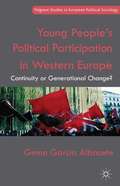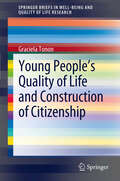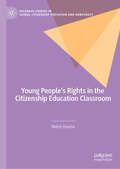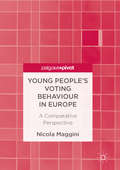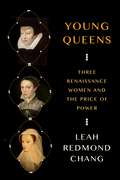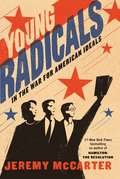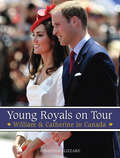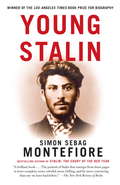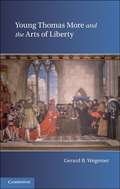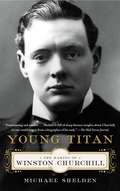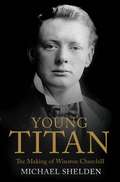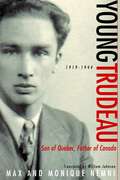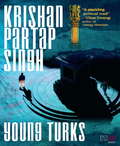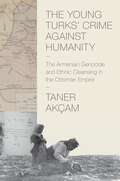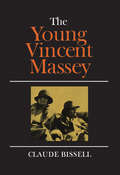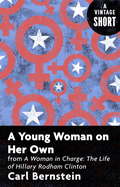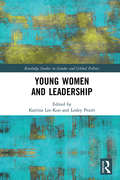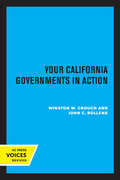- Table View
- List View
Young People Transitioning from Out-of-Home Care
by Pamela Snow Philip MendesThis book challenges and revises existing ways of thinking about leaving care policy, practice and research at regional, national and international levels. Bringing together contributors from fifteen countries, it covers a range of topical policy and practice issues within national, international or comparative contexts. These include youth justice, disability, access to higher education, the role of advocacy groups, ethical challenges and cultural factors. In doing so it demonstrates that, whilst young people are universally a vulnerable group, there are vast differences in their experiences of out-of-home care and transitions from care, and their shorter and longer-term outcomes. Equally, there are significant variations between jurisdictions in terms of the legislative, policy and practice supports and opportunities made available to them. This significant edited collection is essential reading for all those who work with young people from care, including social workers, counsellors, and youth and community practitioners, as well as for students and scholars of child welfare.
Young People Using Family Violence: International Perspectives on Research, Responses and Reforms
by Kate Fitz-Gibbon Heather Douglas JaneMaree MaherThis book examines the use of violence by children and young people in family settings and proposes specialised and age-appropriate responses to these children and young people It interrogates the adequacy and effectiveness of current service and justice system responses, including analysis of police, court and specialist service responses. It proposes new approaches to children and young people who use violence that are evidence based, non-punitive, and informed by an understanding of the complexity of needs and the importance of age appropriate service responses.Bringing together a range of Australian and International experts, it sheds new light on questions such as: How can we best understand and respond to the use of family violence by young people? To what extent do traditional family violence responses address the experiences of adolescents who use violence in family settings? What barriers to help seeking exist for parental and sibling victims of adolescent family violence? To what degree do existing support and justice services provide adequate responses to those using adolescent family violence and their families? In what circumstances do children kill their biological and adopted parents?The explicit focus on child and adolescent family violence produces new knowledge in the area of family violence, which will be of relevance to academics, policy makers and family violence practitioners in Australia and internationally.
Young People, Violence and Strategic Interventions in Sub-Saharan Africa (Clinical Sociology: Research and Practice)
by Kammila Naidoo Oluwafemi Adeagbo Xiaoming LiThis edited volume offers a rich collection of up-to-date research and critical scholarship from various African institutions on incidents of youth violence, intervention and prevention in sub-Saharan Africa. It integrates thinking, evidence, responses, and debates relating to this topic, laying the basis for fresh insights and innovative strategies. The chapters capture a spectrum of pertinent issues such as economic hardship, lockdowns, sexual and reproductive health, pregnancy, online sexual harassment, xenophobic violence, and micro-aggressions in school contexts, and present guidelines on how countries might learn from successful interventions recently implemented. They explore young people’s access to familial and community resources, state-sponsored initiatives, peer counselling, youth-friendly services, and other relevant structures. Thus, among other things, this volume stimulates further debate on what is driving violence in different African contexts—specifically, how intersectional identities create vulnerabilities to violence—and influences ways of dealing with the issue. This interdisciplinary and cross-cutting volume serves as a vital resource for experts at universities, in international organisations, civil society groups and intergovernmental organisations who wish to both analyse and take action to address and prevent the type of violence that currently afflicts young people sub-Saharan Africa today.
Young People's Civic Identity in the Digital Age (Palgrave Studies in Young People and Politics)
by Julianne K. ViolaThis book explores young people’s civic experiences in contemporary American society, and how they navigate the political world in an era defined by digital media. Drawing on the experiences of young people before they have reached voting age, the book provides vital perspectives on citizenship and civic engagement of a part of the population that is often overlooked. The author engages with the tensions young people encounter in their everyday personal and civic lives, particularly in their understanding and experience of civic identity in ways that are shaped by society’s (mis)perceptions of youth. The book introduces a new framework of civic identity that has been directly informed by the lived civic experiences of young people themselves. The findings will be of great interest to researchers and students working in political science, sociology, youth studies, education studies, and media studies, as well as policy-makers, practitioners, and parents of young people.
Young People’s Human Rights and the Politics of Voting Age
by Sonja C. GroverYoung People's Human Rights and The Politics of Voting Age explores the broader societal implications of voting age eligibility requirements and the legislative bar against youth voting in North America and in Commonwealth countries (where 'youth' is defined as persons 16 and over but under age 18). The issue is raised as to whether the denial of the youth vote undermines democratic principles and values and ultimately the human dignity of youth. This is the first book to address the topic of the youth vote in-depth as a fundamental human rights concern relating to the entitlement in a democracy to societal participation and inclusion in influencing policy and law which profoundly affects one's life. Also examined are international perspectives on the issue of voting age eligibility. The book would be extremely valuable for instructional purposes as one of the primary texts in undergraduate or graduate courses on children's human rights, political psychology, political science , sociology of law or society and as a supplementary text for courses on human rights or constitutional law and would be of interest also to members of the general public concerned with children's human rights issues.
Young People’s Political Participation in Western Europe: Continuity or Generational Change? (Palgrave Studies in European Political Sociology)
by Gema M. García-AlbaceteAre young people today politically 'apathetic'? Or are they democratically 'mature' citizens? This book examines several types of involvement to reveal changes in young people's political participation in Europe in recent decades. It uses various concepts of 'age' to compare participation across countries and over time.
Young People's Quality of Life and Construction of Citizenship
by Graciela TononThe study of quality of life refers to the material environment (social welfare) and psychosocial environment (wellbeing). It has been defined as a concept that implies the objective and subjective dimension that Cummins (1997) first studied in seven domains. The use of domains in the quality of life study allows a more precise measurement than the one that could have been reached through simple questions, since psychometric scales are used and if the addition of domains is equivalent to the totality of life satisfaction, then the group of domains is a valid measure of quality of life. In the case of young people, it has been observed that even if they live in negative physical, social and contextual conditions, they can nevertheless experience a relatively positive experience in relation to their quality of life, depending on the strategies and capabilities that they generate in relation to the context. Similarly, young people that live in favorable socioeconomic conditions and with a trouble free psychological situation may experience a relatively poor evaluation of their position in life (Patrick et al). oung people do not form a homogenous group and, in this sense, it is not possible to generalize about youth; they interact with the environment in which they live and they are a product of the history they happen to live, in this way they transit different vital scenarios in daily life that affect their quality of life. The social representations about youth that each population has, in each historical moment, are embedded in the social context in which young people live and develop, conditioning every-day life and /or creating related stereotypes. The concept of youth is a social construction built conjointly by all members of society in the historical moment in which they live. Young people interact with the environment in which they live and they are a product of the history they happen to live. Authors like Urresti (1999) define youth from a point of view that takes into account the living together of different generations in different societies, thus being impossible to compare young people of today with those of two or three decades ago; in addition, he states that it is necessary to situate the understanding of youth within the historical and social moment in which they live. Nowadays the predominant adult model is based in individualism, and even if an intergenerational dialogue is necessary, it is difficult for young people to achieve this kind of communication with adults that, in some cases, are living "stages of youth" or that need to be "forever young". Young people live in uncertainty, with a limited perspective for future action, assigning their own meaning to events and facts, according to their fundamental concerns that are significantly different from those of their parents' generation. In the other side the process of globalization and the protagonist social role of the new informational and communicational technologies, produce that the possibilities to expand individual freedoms increase, but not all young people can manage with it (Lechner, 2002). What young people need in order to construct their citizenship and feel satisfied, varies according to the different societies, especially considering that most of them live a fragile situation. As Cortina (2003:7-9) states, the idea of citizenship always transcends individualism, because the citizen is somebody that exists together with others, and those others are equal to him before the city, is somebody that deliberates with others, that acts with others conjointly, that assumes the protagonist role of his own life, in this way citizen is not only that who the law protects, but that who participates in the public issues. Speaking about young people we propose to recognize them from their equal dignity because "recognition is not only a courtesy that we owe others: it is an essential human need" (Taylor, 1993:46). This recognition is based in human dignity and tends to protect the basic rights of people as individuals and to recognize the particul...
Young People's Rights in the Citizenship Education Classroom (Palgrave Studies in Global Citizenship Education and Democracy)
by Helen HannaThis book explores the rights held by young people in the citizenship education classroom in the divided societies of Northern Ireland and Israel. Against the backdrop of a long history of protracted conflict and division, the author analyses how international rights obligations are reflected in the contested citizenship education curriculum in secondary schools. Drawing upon extensive qualitative data as well as policy and curriculum documents, the author reveals that understandings of education rights can be oriented around three themes – minority group representation in the curriculum, dealing with difference through pedagogy, and preparing young people for life in a (divided) society. This can be mapped onto the 42-A rights framework where education should be ‘acceptable’ and ‘adaptable’. However, the variety of interpretations held by participants raises questions regarding the ‘universality’ of international frameworks for education rights, and the workability of such frameworks in the national and divided contexts. While the contexts of Northern Ireland and Israel have much in common, they are rarely compared: this book will show that their comparison is as relevant as ever, as issues of identity continue to affect everyday school life. This book will be of interest to citizenship and history education scholars, as well as those who are concerned with the application of international human rights law.
Young People’s Voting Behaviour in Europe
by Nicola MagginiThis book uses various concepts of 'age' to examine young people's voting behaviour in six European countries between 1981 and 2000. It addresses questions such as: what are the determinants of voting choices among young people, and to what extent are these factors different from those of adults? Through an innovative approach aimed at studying party choice with a strong empirical orientation, the author argues that age is less important in influencing voting choices than having been young and socialized to politics in a given historical period. Ultimately, values and political factors explain young people's voting choices more than social identities, which marks a change from previous generations. This book will appeal to students and scholars in comparative politics, electoral behaviour, party politics, and political sociology.
Young Queens: Three Renaissance Women and the Price of Power
by Leah Redmond ChangThe boldly original, dramatic intertwined story of Catherine de’ Medici, Elisabeth de Valois, and Mary, Queen of Scots—three queens exercising power in a world dominated by men.Orphaned from infancy, Catherine de’ Medici endured a tumultuous childhood. Married to the French king, she was widowed by forty, only to become the power behind the French throne during a period of intense civil strife. In 1546, Catherine gave birth to a daughter, Elisabeth de Valois, who would become Queen of Spain. Two years later, Catherine welcomed to her nursery the beguiling young Mary Queen of Scots, who would later become her daughter-in-law.Together, Catherine, Elisabeth, and Mary lived through the sea changes that transformed sixteenth-century Europe, a time of expanding empires, religious discord, and populist revolt, as concepts of nationhood began to emerge and ideas of sovereignty inched closer to absolutism. They would learn that to rule as a queen was to wage a constant war against the deeply entrenched misogyny of their time.Following the intertwined stories of the three women from girlhood through young adulthood, Leah Redmond Chang's Young Queens paints a picture of a world in which a woman could wield power at the highest level yet remain at the mercy of the state, her body serving as the currency of empire and dynasty, sacrificed to the will of husband, family, kingdom.
Young Radicals: In the War for American Ideals
by Jeremy MccarterFrom the co-author of the #1 New York Times bestseller Hamilton: The Revolution, the stunning story of five American radicals fighting for their ideals as the country goes mad around them. Where do we find our ideals? What does it mean to live for them—and to risk dying for them? For Americans during World War I, these weren’t abstract questions. Young Radicals tells the story of five activists, intellectuals and troublemakers who agitated for freedom and equality in the hopeful years before the war, then fought to defend those values in a country pitching into violence and chaos. Based on six years of extensive archival research, Jeremy McCarter’s dramatic narrative brings to life the exploits of Randolph Bourne, the bold social critic who strove for a dream of America that was decades ahead of its time; Max Eastman, the charismatic poet-propagandist of Greenwich Village, whose magazine The Masses fought the government for the right to oppose the war; Walter Lippmann, a boy wonder of socialism who forged a new path to seize new opportunities; Alice Paul, a suffragist leader who risked everything to win women the right to vote; and John Reed, the swashbuckling journalist and impresario who was an eyewitness to—and a key player in—the Russian Revolution. Each of these figures sensed a moment of unprecedented promise for American life—politically, socially, culturally—and struggled to bring it about, only to see a cataclysmic war and reactionary fervor sweep it away. A century later, we are still fighting for the ideals these five championed: peace, women’s rights, economic equality, freedom of speech—all aspects of a vibrant American democracy. The story of their struggles brings new light and fresh inspiration to our own.
Young Royals on Tour: William & Catherine in Canada
by Christina BlizzardA day-by-day celebration in words and photographs of the young couple’s first tour of Canada. On April 29, 2011, Prince William of Wales married Catherine Middleton at Westminster Abbey in London. The newlyweds’ first royal tour took place in Canada from June 30 to July 8. People across the country rejoiced with the couple as they made their way through a land that holds special significance for the Royal Family, emphasizing and renewing the bond with Canada. This was not the Duke of Cambridges first trip "home to Canada," since he accompanied his parents, Charles and Diana, in 1991 and his father and brother, Harry, in 1998. This journey included such highlights as Canada Day in Ottawa, dragon boating in Prince Edward Island, visiting homeless youth in Quebec City, street hockey in Yellowknife, and a side trip to help bolster the courage of fire-devastated citizens in Slave Lake, Alberta. The Duke and Duchess presented the vibrant, modern face of the Royal Family, and excitement followed them everywhere as they travelled across Canada.
Young Stalin
by Simon Sebag MontefioreBased on ten years' astonishing new research, here is the thrilling story of how a charismatic, dangerous boy became a student priest, romantic poet, gangster mastermind, prolific lover, murderous revolutionary, and the merciless politician who shaped the Soviet Empire in his own brutal image: How Stalin became Stalin.From the Trade Paperback edition.
Young Stalin
by Simon Sebag MontefioreFollowing up on his earlier Stalin: The Court of the Red Tsar (which won the History Book of the Year Prize at the 2004 British Book Awards), Montefiore here recounts the life of Soviet leader Josef Stalin up to the point of the October Revolution of 1917, focusing on "the intimate and secret, political and personal lives of Stalin and the small circle that ultimately came to create and rule the Soviet Union until the 1960s. " He justifies this focus by suggesting that the personalities and patronage of a minuscule oligarchy were the essence of politics under Lenin and Stalin and that, therefore, Stalin's early history of brigandage, political gangsterism, and paranoia are explanatory of much wider issues of Soviet history.
Young Thomas More and the Arts of Liberty
by Gerard B. WegemerWhat does it mean to be a free citizen in times of war and tyranny? What kind of education is needed to be a 'first' or leading citizen in a strife-filled country? And what does it mean to be free when freedom is forcibly opposed? These concerns pervade Thomas More's earliest writings, writings mostly unknown, including his 280 poems, declamation on tyrannicide, coronation ode for Henry VIII and his life of Pico della Mirandola, all written before Richard III and Utopia. This book analyzes those writings, guided especially by these questions: Faced with generations of civil war, what did young More see as the causes of that strife? What did he see as possible solutions? Why did More spend fourteen years after law school learning Greek and immersed in classical studies? Why do his early works use vocabulary devised by Cicero at the end of the Roman Republic?
Young Titan: The Making of Winston Churchill
by Michael SheldenIn modern memory, Winston Churchill remains the man with the cigar and the equanimity among the ruins. Few can remember that at the age of 40, he was considered washed up, his best days behind him. In Young Titan, historian Michael Shelden has produced the first biography focused on Churchill's early career, the years between 1901 and 1915 that both nearly undid him but also forged the character that would later triumph in the Second World War. Between his rise and his fall, Churchill built a modern navy, experimented with radical social reforms, survived various threats on his life, made powerful enemies and a few good friends, annoyed and delighted two British monarchs, became a husband and father, took the measure of the German military machine, authorized executions of notorious murderers, and faced deadly artillery barrages on the Western front. Along the way, he learned how to outwit more experienced rivals, how to overcome bureaucratic obstacles, how to question the assumptions of his upbringing, how to be patient and avoid overconfidence, and how to value loyalty. He also learned how to fall in love. Shelden gives us a portrait of Churchill as the dashing young suitor who pursued three great beauties of British society with his witty repartee, political f lair, and poetic letters. In one of many never-before-told episodes, Churchill is seen racing to a Scottish castle to prepare the heartbroken daughter of the prime minister for his impending marriage. This was a time of high drama, intrigue, personal courage, and grave miscalculations. But as Shelden shows in this fresh and revealing biography, Churchill's later success was predicated on his struggles to redeem the promise of his youth.
Young Titan: The Making Of Winston Churchill
by Michael SheldenMost people today think of Winston Churchill as simply the wartime British bulldog - a jowly, cigar-chomping old fighter demanding blood, sweat and tears from his nation. But the well-known story of the elder statesman has overshadowed an earlier part of his life that is no less fascinating, and that has never before been fully told. It is a tale of romance, ambition, intrigue and glamour in Edwardian London, when the city was the centre of the world, and when its best and brightest were dazzled by the meteoric rise to power of a young politician with a famous name and a long aristocratic background.Winston Churchill gave his maiden speech in Parliament at the very beginning of King Edward VII's reign in 1901 when he was only 26. By the time the guns of August 1914 swept away the Edwardian idyll, he was First Lord of the Admiralty - the civilian head of the largest navy in the world. In the intervening years, he often cut a dashing figure, romancing several society beauties, tangling with some of the most powerful political figures of his time, championing major social reforms, becoming one of the leading orators of the day, publishing six books, supervising an armed assault on anarchists, and working harder perhaps than anyone else to prepare his nation for war.
Young Titan
by Michael SheldenIn modern memory, Winston Churchill remains the man with the cigar and the equanimity among the ruins. Few can remember that at the age of 40, he was considered washed up, his best days behind him. In Young Titan, historian Michael Shelden has produced the first biography focused on Churchill's early career, the years between 1901 and 1915 that both nearly undid him but also forged the character that would later triumph in the Second World War. Between his rise and his fall, Churchill built a modern navy, experimented with radical social reforms, survived various threats on his life, made powerful enemies and a few good friends, annoyed and delighted two British monarchs, became a husband and father, took the measure of the German military machine, authorized executions of notorious murderers, and faced deadly artillery barrages on the Western front. Along the way, he learned how to outwit more experienced rivals, how to overcome bureaucratic obstacles, how to question the assumptions of his upbringing, how to be patient and avoid overconfidence, and how to value loyalty. He also learned how to fall in love. Shelden gives us a portrait of Churchill as the dashing young suitor who pursued three great beauties of British society with his witty repartee, political f lair, and poetic letters. In one of many never-before-told episodes, Churchill is seen racing to a Scottish castle to prepare the heartbroken daughter of the prime minister for his impending marriage. This was a time of high drama, intrigue, personal courage, and grave miscalculations. But as Shelden shows in this fresh and revealing biography, Churchill's later success was predicated on his struggles to redeem the promise of his youth.
Young Trudeau: 1919-1944
by William Johnson Monique Nemni Max NemniThis book shines a light of devastating clarity on French-Canadian society in the 1930s and 1940s, when young elites were raised to be pro-fascist, and democratic and liberal were terms of criticism. The model leaders to be admired were good Catholic dictators like Mussolini, Salazar in Portugal, Franco in Spain, and especially Pétain, collaborator with the Nazis in Vichy France. There were even demonstrations against Jews who were demonstrating against what the Nazis were doing in Germany.Trudeau, far from being the rebel that other biographers have claimed, embraced this ideology. At his elite school, Brébeuf, he was a model student, the editor of the school magazine, and admired by the staff and his fellow students. But the fascist ideas and the people he admired - even when the war was going on, as late as 1944 - included extremists so terrible that at the war's end they were shot. And then there's his manifesto and his plan to stage a revolution against les Anglais.This is astonishing material - and it's all demonstrably true - based on personal papers of Trudeau that the authors were allowed to access after his death.What they have found has astounded and distressed them, but they both agree that the truth must be published. Translated from the forthcoming French edition by William Johnson, this explosive book is sure to hit the headlines.From the Trade Paperback edition.
Young Turks
by Krishan SinghBest friends Azim Khan and Karan Nehru never considered politics a career choice, but then fate decreed otherwise. Forced by circumstances to rethink their professions, the two friends find themselves willy-nilly contesting elections. Slowly but surely, Azim makes western Uttar Pradesh his electoral fiefdom and begins his journey to becoming the leader of Muslim India; Karan establishes himself as the overlord of eastern Uttar Pradesh and the adjoining states. Together they make their way to the top, never compromising their friendship, until, finally, as cabinet ministers in a shaky coalition government under the prime ministership of the wily former-Congressman Y.K. Naidu, their widely differing ideologies and temperaments, abetted by the malevolence of their colleagues, and the sheer scale of unfolding events, all combine to uphold the conventional wisdom that there are no friends in politics.
The Young Turks' Crime against Humanity: The Armenian Genocide and Ethnic Cleansing in the Ottoman Empire (Human Rights and Crimes against Humanity #15)
by Taner AkçamAn unprecedented look at secret documents showing the deliberate nature of the Armenian genocideIntroducing new evidence from more than 600 secret Ottoman documents, this book demonstrates in unprecedented detail that the Armenian Genocide and the expulsion of Greeks from the late Ottoman Empire resulted from an official effort to rid the empire of its Christian subjects. Presenting these previously inaccessible documents along with expert context and analysis, Taner Akçam's most authoritative work to date goes deep inside the bureaucratic machinery of Ottoman Turkey to show how a dying empire embraced genocide and ethnic cleansing.Although the deportation and killing of Armenians was internationally condemned in 1915 as a "crime against humanity and civilization," the Ottoman government initiated a policy of denial that is still maintained by the Turkish Republic. The case for Turkey's "official history" rests on documents from the Ottoman imperial archives, to which access has been heavily restricted until recently. It is this very source that Akçam now uses to overturn the official narrative.The documents presented here attest to a late-Ottoman policy of Turkification, the goal of which was no less than the radical demographic transformation of Anatolia. To that end, about one-third of Anatolia's 15 million people were displaced, deported, expelled, or massacred, destroying the ethno-religious diversity of an ancient cultural crossroads of East and West, and paving the way for the Turkish Republic.By uncovering the central roles played by demographic engineering and assimilation in the Armenian Genocide, this book will fundamentally change how this crime is understood and show that physical destruction is not the only aspect of the genocidal process.
The Young Vincent Massey
by Claude BissellFor Vincent Massey, youth was a period of protest and emerging public fame. He broke with his strong family traditions of Methodist piety and American ties. He became known as a patron of the arts, innovator, politician, and diplomat.This volume begins with his prosperous Victorian childhood and carries through days as a student and wartime officer. He plans Hart House, which becomes a cultural centre. Promised a cabinet post, he runs for Parliament and is defeated. Instead, he is sent to Washington as Canada's first minister there, and achieves brilliant success. He is prominent in educational circles; he helps to reorganize the Liberal party, presses for progressive policies, and flirts with the idea of replacing Mackenzie King.The book ends in 1935 as he sails to London as his country's high commissioner. He considers it his first major job. In between he writes poetry--usually light, sometimes venom-tipped. He acts, and directs plays. He sponsors a string quartet of international stature. He marries Alice Parkin, a handsome woman of strong convictions, and with her builds a country home near Port Hope, Ontario. He becomes a leading collector of modern Canadian art, and is involved with the painter David Milne. The book is as well a history of the people and ideas which influenced the young Massey--family, teachers, friends, associates. One chapter is given to his relations with Mackenzie King--each of them convinced of his own rightness but separated by fundamental differences, loud in protestations of friendship but nourishing an inner contempt for one another.Claude Bissell has built this complex and absorbing portrait from the unpublished papers of Vincent Massey and members of his circle, diaries of King and other politicians, memories of artists and musicians.He writes with vigour and elegance, quoting extensively from private records and letters, coining epigrams of his own. His portrait is sympathetic but not uncritical, with plenty of scope for the reader to make his own judgements.This is the first of two volumes about one of Canada's best known and least understood figures--statesman, cultural advocate, patron, family man, and first native governor-general.
A Young Woman on Her Own: from A Woman in Charge
by Carl BernsteinA Vintage Shorts Selection From the definitive, humanizing biography of one of the most powerful and widely misunderstood women of our time: Hillary Rodham Clinton. Pulitzer Prize-winning reporter Carl Bernstein sheds light on Hillary's political development during her four years as an impressionable but fierce undergraduate at Wellesley. In thick, Coke-bottle glasses, here is an ambitious young student--galvanized by the assassination of Martin Luther King and the women's liberation movement--fighting to be recognized by the East coast elite. Bernstein reveals a side of Hillary not often seen in a tender, heartening, and measured depiction of her even-keeled transformation from a Barry Goldwater conservative raised in a staunchly anti-communist household in Illinois into an "agnostic intellectual liberal" and an impassioned progressive dedicated to peaceful and pragmatic reform. An ebook short.
Young Women and Leadership (Routledge Studies in Gender and Global Politics)
by Katrina Lee-KooThrough a range of case studies in Asia and the Pacific, this edited collection highlights the extent of the unique ways in which young women lead to create change in their own lives and their communities, as well as in the structures, cultures, and institutions in which they live and work. This volume challenges and reshapes the boundaries and relationships of power that animate traditional attitudes to leadership by exploring the often overlooked role of women as leaders and drivers of social change. The text draws on a number of complex case studies in Asia and the Pacific in order to demonstrate how young women around the world have developed organised approaches to leadership that are often collective, collaborative, and transformative. However, as the authors reveal, they also deviate from traditional forms of leadership that have dominated the literature and public understanding. This book will be of interest to students and scholars of the theory and/or practice of leadership. More broadly, it will also be useful for students and scholars of political science, international studies, peace and conflict studies, international and community development, leadership studies, cultural studies, youth studies, and gender studies.
Your California Governments in Action, Second Edition
by Winston W. Crouch John C. BollensThis title is part of UC Press's Voices Revived program, which commemorates University of California Press’s mission to seek out and cultivate the brightest minds and give them voice, reach, and impact. Drawing on a backlist dating to 1893, Voices Revived makes high-quality, peer-reviewed scholarship accessible once again using print-on-demand technology. This title was originally published in 1960.
